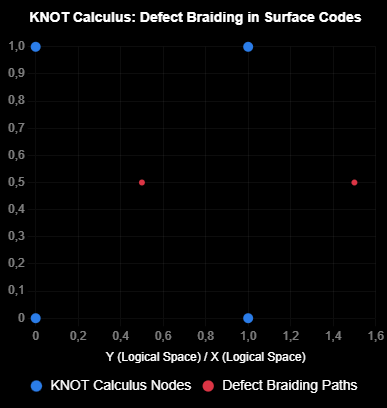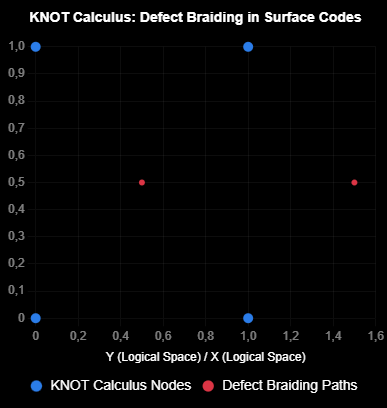String Diagrams for Surface Codes in Pattern Field Theory™
Date: August 24, 2025
How to read this page.
Peer-Reviewed Findings summarize results from Kupper et al. (2025). PFT™ Interpretations map these to the Triadic Field Structure™ (Pi™ = closure, Primes = disruption, Phi = emergence). PFT™ Projections are speculative experiments, clearly marked as not from the paper. Pending experiments will be updated with JSON artifacts.
Peer-Reviewed Findings summarize results from Kupper et al. (2025). PFT™ Interpretations map these to the Triadic Field Structure™ (Pi™ = closure, Primes = disruption, Phi = emergence). PFT™ Projections are speculative experiments, clearly marked as not from the paper. Pending experiments will be updated with JSON artifacts.
Peer-Reviewed Findings
Source: Mateusz Kupper, Dominic Horsman, Chris Heunen, & Niel de Beaudrap, “String Diagrams for Defect-Based Surface Code Computing,” EPTCS 426, pp. 159–196 (2025) — arXiv:2508.14672 • DOI:10.4204/EPTCS.426.6.
- KNOT Calculus: A graphical calculus (KNOT) models logical effects of defect braiding in surface codes, equivalent to the (0, π)-fragment of ZX-calculus.
- Subtheories: “Ribbon-like” and “tangle-like” subtheories define standard encoding techniques for defect braiding, with distinct semantics in the (0, π)-fragment.
- Soundness and Completeness: Both subtheories are sound and complete for the (0, π)-fragment (no byproducts).
- Diagram Transformations: String diagrams describe defect braiding operations, with rules (e.g., K5, K8) for transforming between ribbon-like and tangle-like forms.
- PT-Symmetry Link: References PT-symmetric transfer matrices (Mattei & Milton, 2017) for stable wave propagation in space-time microstructures.
Key Equation:
\[ \text{KNOT Rule (K5):}\quad = \quad \text{(fusion rule for string diagrams)} \]
\[ \text{KNOT Rule (K5):}\quad = \quad \text{(fusion rule for string diagrams)} \]
Fusion rule merges nodes in string diagrams, corresponding to defect operations in surface codes.

PFT™ Interpretation
The following maps the paper’s findings to PFT™’s Triadic Field Structure™ (not claims of the paper):
- Coherence Channels: String diagrams represent Pi-Field coherence channels, with unit-circle spectra ensuring locked coherence, akin to field patterns (Mattei & Milton, 2017).
- Triadic Mapping: Equal-speed matching in KNOT transformations aligns with Pi™ (closure). Destabilizing parameter orderings correspond to Primes (disruption). Persistent oscillatory wakes reflect Phi (emergence).
- Design Rule (Lab-Ready): Enforce \( c_i \) equality within the unit cell and select \(\gamma\) orderings to keep spectra on the unit circle (Eq. 3.16 in paper), enabling a “locked-coherence waveguide.”

PFT™ Projections & Pending Experiments
These are speculative PFT™ extensions, not claims of the paper:
- CMBR Tri-Shifts: Search for eigenvalue-like gaps in \( C_\ell \) (CMB power spectra). Tooling:
cmbr_trishift.py. Status: Pendingresults/cmbr_metrics.json. - Trivergence Simulation: With zero tension, predict unit-circle-like coherence (equal-speed analogue). Status: Pending
results/trivergence.json. - JWST “Light Strays”: Look for oscillatory-wake analogues in lensing offsets (~0.05–0.1 arcsec). Status: Methods being specified.
- Prime Scaffolds: Compare 4-phase \(\gamma\) orderings to prime-structure signatures from pi-hacking. Status: Analysis queued.
Context & Recommended Reading
- PT Symmetry: Bender & Boettcher (1998); El-Ganainy et al. (2018).
- Space-Time Metamaterials: Caloz & Deck-Léger (2020) Parts I & II; Galiffi et al. (2022).
- Hyperbolic Metamaterials: Poddubny et al. (2013).
Related PFT™ Articles
- The Breach Event
- Field Patterns Without Blow Up
- Fractal Time (Timeframes)
- Correcting Mathematics
- Pi Emergence
- Ratio & Internal Measurement
- Geometry is Relationship
Artifacts & Repos
- results/cmbr_metrics.json (placeholder)
- results/trivergence.json (placeholder)
- Proposed GitHub:
- patternfieldtheory/breach-event-simulation —
breach_simulation.py - patternfieldtheory/cmbr-tri-shifts —
cmbr_trishift.py
- patternfieldtheory/breach-event-simulation —
References
- Kupper et al. (2025) — String Diagrams for Defect-Based Surface Code Computing • DOI
- Mattei & Milton (2017) — Field patterns without blow up • DOI
- Caloz et al. (2020) — Spacetime Metamaterials — Part I: General Concepts
- Payot et al. (2023) — Fractal boundaries in chaotic dynamical systems
- Pastén & Cárdenas (2023) — Fractal LTB models
- Poddubny et al. (2013) — Hyperbolic metamaterials
Join the PFT Revolution
Contact info@patternfieldtheory.com.
Attribution: Portions of text draw on PFT™’s SynchroMath™ framework. Pattern Field Theory™ (PFT™), SynchroMath™, and related marks are claimed trademarks. All rights reserved.